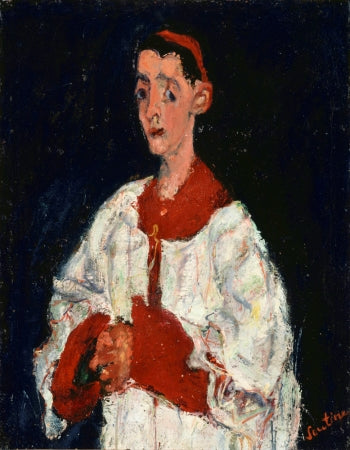Descriere
Pictura „Monaguillo” (1928) a lui Chaim Soutine este un exemplu fascinant al stilului său distinctiv și o reprezentare șocantă a figurii umane, adesea marcată de emoție și o intensitate aproape viscerală. În această lucrare, Soutine prezintă un copil, probabil un băiat de altar, într -o poză care evocă atât inocența tinereții sale, cât și greutatea rolului său într -un context religios. Copilul este îmbrăcat într -o haină albă care contrastează cu fundalul întunecat și aproape abstract, un efect care agravează atenția privitorului față de fața sa și expresia lui.
Compoziția se caracterizează printr -o abordare care sfidează convențiile tradiționale ale portretului. Utilizarea culorii este interesantă: Soutine folosește o gamă de tonuri întunecate pentru spatele întunericului. Această dinamică nu numai că evidențiază subiectul principal, dar sugerează și o stare de contemplare, o căutare internă care poate fi interpretată ca o reflectare a spiritualității asociate cu rolul unui băiat de altar.
Fața copilului este una dintre cele mai fascinante zone de pictură. Soutine, cunoscută pentru capacitatea sa de a capta fizionomia umană cu o energie aproape sălbatică, prezintă Monaguillo cu caracteristici faciale care evocă atât tandrețe, cât și anxietate. Această ambivalență emoțională este una dintre mărcile înregistrate ale activității lui Soutine; Găsiți frumusețea în imperfecțiuni și neobișnuite, oferind o viziune cinstită și brută asupra subiectelor lor. Prin periajul său rapid și hotărât, Soutine reușește să transmită nu numai aspectul copilului, ci și un sentiment al esenței sale.
Utilizarea culorii în „Monaguillo” este demn de menționat, deoarece Soutine este cunoscută pentru emoțional și expresionist al vopselei. Aici, contrastul dintre obiceiul alb și fundalul întunecat stabilește o narațiune vizuală despre sacrificiu și devotament. Culorile sunt vibrante și, în același timp, uzate, creând o textură bogată care invită privitorul să se apropie și să aprecieze subtilitățile perii. Fiecare linie pare a fi încărcată de emoție, ceea ce face ca munca să rezoneze la un nivel mai profund.
Soutine, unul dintre cei mai proeminenți reprezentanți ai expresionismului în arta secolului XX, a fost frecvent legată de școala de la Paris, unde a înflorit cariera sa. Adesea înfățișa o varietate de subiecte, de la animale la peisaje și figuri umane, fiecare infuzat cu stilul său pasional particular. Lucrarea sa nu numai că reflectă realitatea sa personală, marcată de deplasări și nesiguranțe, dar vorbește și despre o abordare modernă despre portret, care contestă idealizarea și susține o reprezentare mai autentică și viscerală.
„Monaguillo” poate fi văzut ca parte a celei mai largi narații a artei lui Soutine, care se caracterizează printr -o căutare internă prin extern. Ca și în alte lucrări ale artistului, în acest tablou tensiunea dintre divin și om, se simte o explorare constantă care oferă privitorului un spațiu pentru reflecție. Soutine îl provoacă pe spectator să se confrunte cu umanitatea copilului în contextul sacrului, creând astfel o lucrare care este atât un portret al unui tânăr Monaguillo, cât și un comentariu asupra complexității experienței umane în cadrul spiritualității. În concluzie, „Monaguillo” este un plus valoros la corpul artei contemporane, bogat în simbolism și unde emoția joacă un rol fundamental, fidel vocii unice a lui Chaim Soutine.
KUADROS ©, o vopsea faimoasă pe peretele tău.
Picturi de ulei realizate manual, cu calitatea artiștilor profesioniști și sigiliul distinctiv al KUADROS ©.
Imagini Serviciu de reproducere cu garanție de satisfacție. Dacă nu sunteți complet mulțumit de replica tabloului dvs., vă rambursăm banii 100%.

